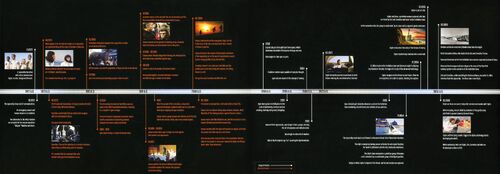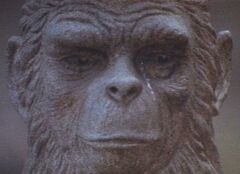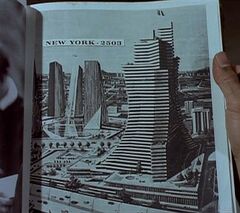GusF (Message Wall | contribs) (Correcting link.) |
No edit summary |
||
| Line 51: | Line 51: | ||
==External Links== |
==External Links== |
||
| + | *[https://pota.goatley.com/ape-chronicles/ape-chronicles-013.pdf ''The 25th Anniversary Chronology''], by Jeff Krueger - 'Ape Chronicles' #13 (1994) at [http://pota.goatley.com Hunter's Planet of the Apes Archive] |
||
*[http://pota.goatley.com/scrolls/simianscrolls_16.pdf ''Planet of the Apes: The TV Series - where does it fit in the POTA franchise?''], by James Aquila - 'Simian Scrolls' #16 (2010) |
*[http://pota.goatley.com/scrolls/simianscrolls_16.pdf ''Planet of the Apes: The TV Series - where does it fit in the POTA franchise?''], by James Aquila - 'Simian Scrolls' #16 (2010) |
||
*[http://pota.goatley.com/scripts.html Hunter's Planet of the Apes Scripts Archive] |
*[http://pota.goatley.com/scripts.html Hunter's Planet of the Apes Scripts Archive] |
||
==References== |
==References== |
||
| − | |||
<div class="references-small"> |
<div class="references-small"> |
||
<references/> |
<references/> |
||
Latest revision as of 08:54, 16 May 2020
It is debated whether the the original Planet of the Apes film pentalogy represents a single circular timeline or two linear timelines.
Screenwriter Paul Dehn created the story-arc for the films he devised (as co-writer of Beneath and Battle and sole writer of Escape and Conquest) that would lead inevitably back to the start of the original movie. Speaking in 1972 upon the release of Conquest of the Planet of the Apes, he stated, "I fitted it together so that it fitted in with the beginning of 'Apes 1', so that the wheel had come full circle and one could stop there quite happily, I think."[1] "The whole thing has become a very logical development in the form of a circle. I have a complete chronology of the time circle mapped out, and when I start a new script, I check every supposition I make against this chart to see of it is correct to use it"[2].
However, despite Dehn's clear intent, there are numerous discrepancies and continuity errors between the films which lead many to interpret these discrepancies as evidence that the timeline was altered. Their argument contends that by reversing through time, Zira, Cornelius, and Milo changed the course of the planet's history and that the events of Planet of the Apes and Beneath the Planet of the Apes were therefore nullified — a Linear (altered) timeline, rather than the looping, unchanging series of events that a Circular timeline represents. However, it is never stated, directly and indirectly, in any of the films that this is what happened.
The evidence in support of this theory rests solely on Cornelius' sworn statement in Escape from the Planet of the Apes in which he tells of the origins of the society encountered by Taylor and Brent, and of an ape named Aldo who first defied his human masters after five centuries of slavery. The next film Conquest of the Planet of the Apes shows a slightly different version of these events. Instead Zira and Cornelius' son Caesar leads an ape revolution after a mere eight years of servitude, instead of the three centuries Cornelius had described. Cornelius had further testified that it took two centuries for apes to go from pets to slaves after a plague had wiped out dogs and cats but, while the plague is confirmed as having occurred in 1982 in Conquest, how these events were accelerated from two centuries to just nine years while Caesar was in Armando's circus is never explained. So while many of the events are the same, the timeframe is different. This could indicate either an altered timeline or just an inaccurate history that was distorted by the apes over the centuries.
When creating a final chapter in the Apes saga, Battle for the Planet of the Apes, the choice of whether the ending should slide towards the ape-master/mute-human society depicted in the first film or a more optimistic alternative future became an issue. Otto Hasslein had already explained the possibility of altering history in Escape when he proposed ending the genetic line of the time-traveling apes, and his theories were echoed by Virgil during the start of Battle, and seized upon by Caesar.
After Dehn's temporary withdrawal from the project, John William Corrington & Joyce Hooper Corrington were evidently in favor of an altered timeline when writing a story outline for Battle (then named Epic of the Planet of the Apes): the prologue and epilogue of the movie are set in 2670 A.D., and the Lawgiver is now benevolent towards humans, rather than the anti-human fanatic suggested in Planet and Beneath (although this Lawgiver does still speak of "evil men who betrayed God's trust"); "[This] difference," they state, "is due to alterations of that historical track which we have seen worked out in previous films...these changes in ape history are due primarily to the influence of Caesar on apes and humans." Of course, the Corringtons had no involvement in writing either Escape or Conquest, so theirs was a retroactive interpretation or misinterpretation of Paul Dehn's story arc.
The key moment in this story outline is Caesar's discovery of audio tapes of his parents describing the planet's destruction 2,000 years in the future, and the role of an ape named Aldo in setting these events in motion. Caesar declares, "Trust me. If history can be changed, time altered, we'll do it." The Corringtons underlined the point thus: "The main premise of 'Epic' is that Caesar, discovering the tapes ...determines that the course of history must be changed such that when Taylor arrives two millennia later he will find peace and justice instead of the slavery and brutality of 'Planet' which led directly to the atomic destruction of the world by the doomsday bomb.... The perspective given us by the prologue-epilogue frame indicates that Caesar has some success since an integrated ape-human society is awaiting the coming of Taylor, but the question of the planet's ultimate destiny is left open."
Similarly, in interviews conducted for the End of an Epic: The Final Battle documentary featurette (found on the 2008 Battle for the Planet of the Apes Blu-Ray edition), several commentators stated that the main thrust of the film's plot was that it was possible to alter the timeline and create a more hopeful future through Caesar's actions in Battle; as co-screenwriter Joyce Hooper Corrington asked, "Are we caught in this time-line that goes again to destruction, or are they going to do better? ... At the end, you do see the ape children and the human children playing together, but then in the background we had a couple of little kids fighting, an ape and a human child fighting, indicating that there's still going to be a struggle. We don't know for sure. We hope we're in a new time-line, we hope we're not going to destroy ourselves, but the potential is still there."[3]
There also is some inconsistency in the Linear theory here: If Cornelius's version of history has already been altered by Caesar's revolution, then his testimony about Earth's future is unreliable. This "main premise" of the Corringtons' story only makes sense if Caesar's revolution on its own will still ultimately lead to the events of Planet and Beneath, or else Caesar is completely mistaken in deciding he must take action to alter a course of history that has already been negated, in which case the film is dramatically pointless.
The Corringtons' outline also featured the ancestors of the mutants from Beneath (as had Dehn's first treatment for the film) with the very bomb that would destroy the Earth, and ended with a human child and an ape child having a fight. The Corringtons were ultimately replaced by a returning Paul Dehn, who rewrote much of the film's dialogue. and made other alterations.
In the final script, the fight was reduced to a chimp-child cheekily pulling the hair of a human girl and, though filmed, the finished movie removed the scenes involving the bomb, making the planet's destruction look even less inevitable. However, though Paul Dehn's closing shot of a statue of Caesar shedding a tear has been interpreted by some fans as a tear of joy at the good-natured human/ape integration that his legacy has brought about, Dehn himself stated that it was to tell the audience that Caesar's efforts would ultimately fail[4].
- For a detailed breakdown of the sequence of events in a Linear Apes timeline, see A Chronology of the Planet of the Apes created by Nigel Brown in 1975.
It is possible, by employing the Linear Timeline theory, to create an entirely variant future for the planet beyond the conclusion of Battle, with numerous possibilities. Illustrating this, a graph featured in the Planet of the Apes Blu-Ray collection in 2008 showed two timelines side-by-side, with one detailing the original ape revolution, and the other the premature revolt led by Caesar.

Timeline from the 2008 Blu-Ray boxed set released by Fox Home Entertainment, showing an altered course of history
The concept of Taylor crash-landing on an altered-future Earth was supposedly the basis for an abandoned Planet of the Apes sequel being developed by James Cameron around 1997.
The same theory could also allow the Apes TV series to be included in the same continuity as the movies; the photograph of a futuristic New York in 2503 A.D. would place the series in the alleged original timeline, where an ape revolution was not due to take place until over 500 years after the point when Zira and Cornelius appeared.
One could even suppose that the Return to the Planet of the Apes animated series could be placed in the altered timeline as an alternative version of the events of 3979 A.D., or that the different date-readings in Planet and Beneath might be explained by them being in different (albeit remarkably-similar) timelines, though both these possibilities would imply that mankind was still destined to be dominated by the apes, regardless of the changed course of history.
However, the biggest flaw with the Altered Timeline theory is that is rests almost totally on Cornelius's sworn statement in Escape from the Planet of the Apes, and that in itself has several problems. Firstly, according to the history that Cornelius relates, the downfall of man took place in the 25th century. However, this is inconsistent with what had been established the two previous films (Planet and Beneath), which stated that a 20th century nuclear war had destroyed human civilization, leading to the ascendance of apes. It is also inconsistent with Cornelius's own earlier statement in Escape, that apes had been speaking English for almost 2,000 years.
Secondly, the sources of Cornelius' testimony were secret sections of the Sacred Scrolls. However, in Planet of the Apes, it was shown that the Scrolls were highly inaccurate with regard to the apes' history, making them a very questionable source. Thus, the events of both Conquest of the Planet of the Apes and Battle for the Planet of the Apes can be consistent with what was established in Planet of the Apes and Beneath the Planet of the Apes, with the only real inconsistency being Cornelius' statement, which came from a source that had previously been shown to be "not worth their parchment."
The majority of Planet of the Apes fans — both casual and devoted — consider the movie series to be a continuous loop, with the contradictions due either to mistaken or misleading statements of history. Other fans believe that the alterations are only minor, and lead to the same ultimate conclusion. The scenes deleted from the original cut of Battle — showing the beginning of a mutant Alpha-Omega Bomb cult — support this hypothesis, and their restoration to the 2006 DVD reissue strengthens the argument for a circular timeline.
This has been the structure followed by almost all timelines constructed to demonstrate the course of Apes events, including the first such timeline in Marvel Comics 1970s Planet of the Apes Magazine, Rich Handley's Timeline of the Planet of the Apes: The Definitive Chronology, the Fox 30th Anniversary Apes website which was included on the DVD-ROM of the Battle DVD and those appearing on websites such as Empire Online and IGN. However, the gate-fold cover of the Blu-Ray boxed set released by Fox Home Entertainment in 2008 utilized the Altered Timeline theory, showing a divergent course of history begun by the events of Escape.
Spin-off Apes media has tended to avoid or ignore the question of alternate timelines. As mentioned, the live action and animated TV series' made little effort to co-ordinate with movie continuity. Marvel Comics' original stories (aside from Quest for the Planet of the Apes) likewise made only passing reference to the movies, although Kingdom on an Island of the Apes used the legacy of the first movie as a springboard, and Terror on the Planet of the Apes seemed to be stylistically influenced by Battle, especially in early episodes.
Malibu Graphics' 1990s comics, in contrast, were rooted firmly in a post-Battle universe, with humans already mute just two generations on from Caesar's revolt. Their main comic series ended with renewed promises of ape/human harmony, but shortly afterwards the final spin-off mini-series Planet of the Apes: The Forbidden Zone — set centuries later in the same universe — showed things had quickly reverted in Ape City, completely at odds with the scenes in Battle of a Lawgiver teaching a mixed group of children in 2670 A.D. (although it could be suggested that these filmed scenes were set in the rival town of "Primacy," where peace reigns).
Lowell Cunningham, writer of that mini-series, set out his "circular" take on the timelines in the introduction to one issue: "The first two Apes films featured characters traveling into the future, but it wasn't until the third film that the series ventured into real paradox territory. Having the characters travel into the past and participate in events which lead to their future creates a closed loop (or perhaps strange loop would be a better term). How could Zira and Cornelius, in their past set into motion the events which lead to their future? This leads us to a problem called reverse causality — the future causing changes in the past — which is the same situation created in both Terminator films... Is there an answer to the questions of time travel? Is it possible to close all the loopholes and explain everything away? I sure hope not, that would make things a lot less interesting."
While Dark Horse Comics' series dealt exclusively with the continuity of the 2001 Planet of the Apes re-imagining, MR Comics' Revolution on the Planet of the Apes featured Breck and Kolp possessing the Alpha-Omega Bomb, again reinforcing a circular timeline theory.
See Also: Continuity
See Also: Timeline
External Links
- The 25th Anniversary Chronology, by Jeff Krueger - 'Ape Chronicles' #13 (1994) at Hunter's Planet of the Apes Archive
- Planet of the Apes: The TV Series - where does it fit in the POTA franchise?, by James Aquila - 'Simian Scrolls' #16 (2010)
- Hunter's Planet of the Apes Scripts Archive
References
- ↑ Cinefantastique 'Planet of the Apes' Issue (1972) at Hunter's Planet of the Apes Archive
- ↑ The Planet of the Apes Chronicles by Paul A. Woods (Page 109)
- ↑ End of an Epic - Planet of the Apes Blu-Ray Box-Set (2008)
- ↑ Planet of the Apes Revisited by Joe Russo and Larry Landsman (Page 211)


